Are you a Quiet Speculation member?
If not, now is a perfect time to join up! Our powerful tools, breaking-news analysis, and exclusive Discord channel will make sure you stay up to date and ahead of the curve.
Time waits for no man, as they say, and Magic is the same for all players. Good advice will always be good advice, but relevance is relative. By the same token, Magic players need advice that is relevant to formats as they actually exist. And that must be re-evaluated periodically.
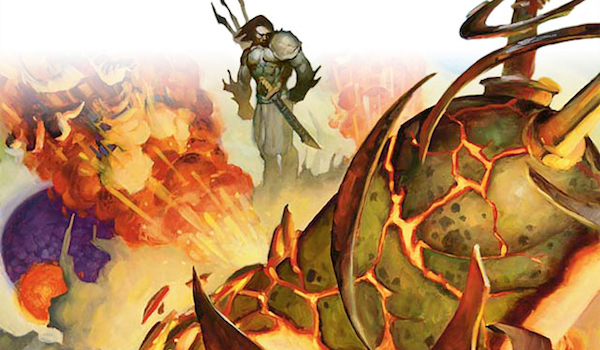
The second Beginner's Guide article I ever wrote dealt with the differences between Modern and Standard sideboards. Standard was about tuning matches; Modern is about bullets, and countering opposing bullets. That general advice still stands. However, I also included a number of rules to serve as a guide for new players. And those needs to be reexamined. In the four years since that article, Modern has changed a lot. Correctly choosing sideboard cards is more important than ever, and the how is trickier than ever. Thus, I need to update not only the rules themselves, but the reasoning behind them.
The Card Selection Rules
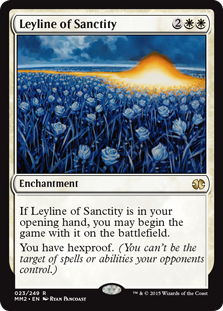 First and foremost are the card selection rules. The original ones read thusly:
First and foremost are the card selection rules. The original ones read thusly:
1) Sideboard cards should be good no matter when they're drawn
2) Play four of the most important cards
The reasoning was that Modern is very cantrip-poor and features powerful aggro decks. There's no time to durdle around, and even if there was, the available cantrips didn't offer much in the way of card selection. The only one worth mentioning at the time was Serum Visions. More pressingly, a lot of highly played cards were only good at the very start of the game. It was therefore essential to maximize the odds of actually having the card early. Leyline of Sanctity is a beating against Jund if and only if it hits on turn 0. If there's no space for all four, it's better to run cards that are good whenever they're drawn.
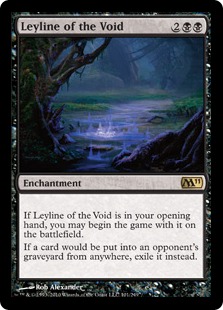 Over the course of the series, another rule emerged. Initially, I didn't think of it as a rule, but the larval form of the idea is definitely present in the original article. As I wrote more articles, it became more clearly articulated as:
Over the course of the series, another rule emerged. Initially, I didn't think of it as a rule, but the larval form of the idea is definitely present in the original article. As I wrote more articles, it became more clearly articulated as:
3) Play widely applicable cards.
Modern is very diverse and it isn't possible to have cards for every single matchup, or even to contemplate all the different decks that might appear at a given tournament. So preparing specific hate or answers is pretty pointless. It's far better to play cards that have a wide range of applications as a result.
I stand strongly behind rule 3, and actually think that it has gained importance over time. As more and more cards enter the format, the number of plausible decks just keeps rising. Decks don't stay tier 1 or even tier 2 for years, as they once did. Flexibility is the name of the sideboarding game in Modern.
London's Influence
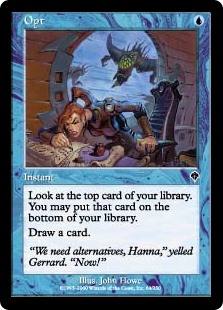 The first two rules, on the other hand, have lost a lot of their punch. It's not that Modern's got the cantrips to make digging viable for bullets easier now. Opt is not Ponder, and Modern still isn't Legacy-lite. Rather, a major rules change has made finding sideboard cards sufficiently easier that niche answers are much better today than they were in 2016.
The first two rules, on the other hand, have lost a lot of their punch. It's not that Modern's got the cantrips to make digging viable for bullets easier now. Opt is not Ponder, and Modern still isn't Legacy-lite. Rather, a major rules change has made finding sideboard cards sufficiently easier that niche answers are much better today than they were in 2016.
The London Mulligan has had a significant effect on Magic by severely reducing variance in opening hands. I won't get into the math here because that's what linking Frank Karsten is for, but the bottom line is that mulliganing aggressively for specific cards is far more effective now than ever before. Therefore, running more niche sideboard cards or running less than a full set is less punishing, and often correct. Sideboarding guides need to reflect this fact and acknowledge that reactive sideboarding is now at its best.
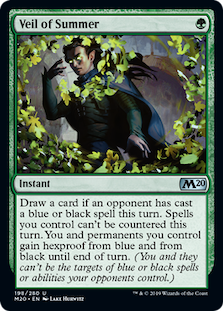 For proof, look no further than Veil of Summer. The card is absolutely everywhere and a significant beneficiary of the London Mulligan. The similar Autumn's Veil and numerous variants existed prior to 2016, but didn't see much play. Granted, Veil of Summer is significantly more powerful than any other option thanks to cantripping and giving players hexproof too, but that's not the whole story. The most widespread use for Veil in Modern has been to counter Thoughtseize, and that's far harder without London.
For proof, look no further than Veil of Summer. The card is absolutely everywhere and a significant beneficiary of the London Mulligan. The similar Autumn's Veil and numerous variants existed prior to 2016, but didn't see much play. Granted, Veil of Summer is significantly more powerful than any other option thanks to cantripping and giving players hexproof too, but that's not the whole story. The most widespread use for Veil in Modern has been to counter Thoughtseize, and that's far harder without London.
To make such a play requires a convergence between two players, and there are a lot more playable targeted discard spells than one-mana counters. Thus, it was more likely for the discard player to see their cards than the Veil player, and so Veil's utility was limited. The only time I remember Autumn's Veil seeing play was to protect Scapeshift from counters. And Boseiju, Who Shelters All was just better. The London Mulligan dramatically improves the odds of having Veil of Summer in a given hand, making it more likely to counter Inquisition of Kozilek, which makes it more powerful a card than Autumn's Veil despite being just as niche.
Card Selection: The New Rules
With that in mind, here are my updated sideboard card selection rules:
1) Play widely applicable cards
Just as I said above, Modern has a huge number of distinct decks. It is impossible to prepare for everything. It's better to be ready for a wide variety of decks. The best achievable goal is still to target specific interactions that see widespread play rather than specific decks. However, even when selecting cards with specific decks in mind, it's best to ensure that they're not for just that deck. Modern remains a format where you can, through no fault of your own, dodge the best and most widely played deck in the room for a whole tournament.
2) Play the best card for the job
Or at least, the best that can fit into your deck. Modern's gotten powerful enough that playing cards that hedge your bets is giving up value. There was a time that good enough was good enough, but there are sufficient options now that every deck should be able to play the most high-impact sideboard cards in their colors. This might sound like it's at odds with the first rule, but they're not mutually exclusive. Much like Veil of Summer has many uses in many matchups, it's also the best option for forcing through spells and protecting them from targeted discard. Players need to look for devastating cards that are useful in multiple matchups.
3) The number of slots should reflect the card's importance
In an age of Karn, the Great Creator incentivizing wishboards, it's easy to forget that sideboard cards aren't all tutor targets. Outside of wish targets, the number of slots a given 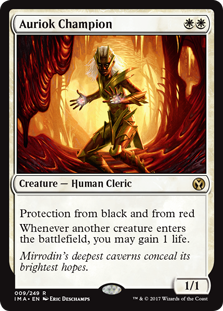 sideboard card gets should reflect its importance to a matchup. When you really need a specific card, you still need to run a full set. The London Mulligan only goes so far, and trying to mulligan for a one-of bullet is still not strategically favorable.
sideboard card gets should reflect its importance to a matchup. When you really need a specific card, you still need to run a full set. The London Mulligan only goes so far, and trying to mulligan for a one-of bullet is still not strategically favorable.
Humans struggles massively against Prowess without Auriok Champion. With Champion, the matchup is still not great, but it is winnable. This is why Humans has taken to full sets of Champion recently while utility spells like Dismember and Deputy of Detention are two-ofs. They're good in the right situations, but not necessarily essential to victory, unlike Champion, and so can be deemphasized. Champion is also a great example of a card that works in many matchups (Jund, Shadow, Burn, other aggro decks) and is the best card at what it does given Humans's deck restrictions.
The Matchup Rules
Next, there were the guides for specific matchups. I was writing just after the end of Eldrazi Winter, and Modern was still trying to figure itself out. However, there were a few constants 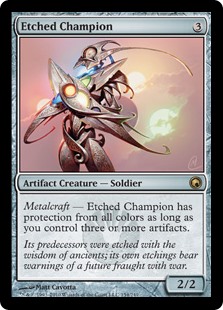 that were worth discussing. I said that players should:
that were worth discussing. I said that players should:
1) Not concede to Affinity
2) Not concede to Dredge
3) Win the close matchups
4) Not lose good matchups
5) Only try for bad matchups if they're winnable
The reasoning for the first two: these were strong decks that are easily hated on, making it silly to just ignore them. Those are match points being left on the table. The latter three are the prioritization list for matchups. The close matchups are where sideboarding strategy will be most important, as the maindecks are so closely matched. Next, the good matchup is usually good thanks to some advantage inherent to a deck. Don't let that slip away. Finally, every deck has an unwinnable matchup. Just accept it and move on. It may not matter in a tournament, and turning it around takes too much space. If a small change can turn things around, then by all means. But don't prioritize moving a matchup from 20% to win to 40%. You should be trying for 50% to 60%.
Shifts of the Format
The first two rules are obviously problems for current Modern. Most glaringly, Affinity is no longer a deck. It started to fade away in 2017 before being replaced by Hardened Scales in 2018. Artifact decks in general proliferated after that thanks to Whir of Invention, Arcum's Astrolabe, and Urza, Lord High Artificer, so I could have morphed that point into a general 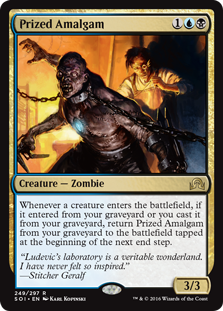 point about artifact decks. However, banning Mox Opal has completely killed artifact aggro, and Astrolabe's ban finished off artifact decks in general. Whirza still pops its head up occasionally, but it's so rare that there's no need to worry anymore.
point about artifact decks. However, banning Mox Opal has completely killed artifact aggro, and Astrolabe's ban finished off artifact decks in general. Whirza still pops its head up occasionally, but it's so rare that there's no need to worry anymore.
Dredge has gone the complete opposite direction. Golgari Grave-Troll's unbanning had only recently borne fruit with the printing of Prized Amalgam, and at the time I was considering dropping graveyard hate altogether. Oh, to be that naïve and hopeful again. The intervening years have seen Dredge rise and fall but graveyard-centric decks ramped up their presence. It's more important than ever to be ready for graveyard decks and play the hate.
Keeping Priorities Straight
Meanwhile, the rules about matchup prioritization are still valid, though there's some adjustment needed. With Modern being so diverse, it's more important than ever to be aware of where a deck stands in a given matchup and prepare accordingly. The addition of new cards has also made it easier to plan around known sideboard strategies and answers. Thus, while the priorities have not changed, how players have to deal with those matchups has.
Matches: The New Rules
Here are my revised rules for match selection:
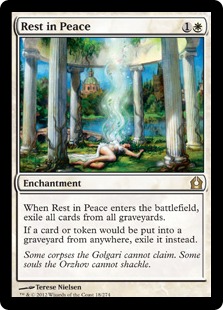 1) Play effective graveyard hate. No exceptions; no excuses
1) Play effective graveyard hate. No exceptions; no excuses
Look, there are lots of graveyard centric decks in Modern, and they consistently do well. Off the top of my head I can think of the compendium of Uro, Titan of Nature's Wrath decks, Jund, Lurrus of the Dream-Den, Death's Shadow, and yes, Dredge is still... (dead?) and kicking. Every deck will hit some other deck that requires hate. There's enough hate that has an additional upside now that there are no excuses for skimping. Stop letting the Zombies off easy!
2) Hate out common, vulnerable decks
You can't be ready for everything. But there is no excuse for not being ready for certain decks. I'm specifically thinking of Amulet Titan and Tron, though Storm and Ad Nauseam are in the same boat. These are common decks that are all hit, and hit hard, by Damping Sphere. Every deck has access to something effective against these decks now-a-days, so don't give them a pass unless the matchup is unlosable or unwinnable for other reasons. This applies to other decks besides the aforementioned; I'm just not listing all of them.
3) Have a specific strategy in mind for targeted matchups
It's not enough to just play effective cards; everybody does that these days! They now need to be deployed in a more strategic manner, as follows.
- High Priority: Win Close Matchups
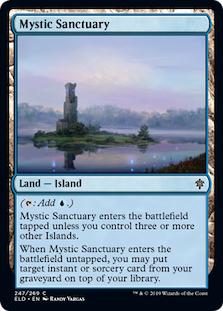 This is harder than it used to be, partially because of more and better cards in the pool, and partially because more information on decks is more widely available. Players will be more prepared and are unlikely to straight-up lose to powerful cards. Strategic changes are needed to compliment and enhance the sideboard cards. Players need to prioritize figuring out what matters most after sideboarding, and either target that aspect or dodge it. A classic example of the former is Jund leaning into the attrition of the mirror by boarding out the more situational discard spells for universally useful planeswalkers and card advantage. An example of the latter is ditching the card advantage fight in the control mirror by boarding in Geist of Saint Traft to slide under clunky counterspells and end things quickly.
This is harder than it used to be, partially because of more and better cards in the pool, and partially because more information on decks is more widely available. Players will be more prepared and are unlikely to straight-up lose to powerful cards. Strategic changes are needed to compliment and enhance the sideboard cards. Players need to prioritize figuring out what matters most after sideboarding, and either target that aspect or dodge it. A classic example of the former is Jund leaning into the attrition of the mirror by boarding out the more situational discard spells for universally useful planeswalkers and card advantage. An example of the latter is ditching the card advantage fight in the control mirror by boarding in Geist of Saint Traft to slide under clunky counterspells and end things quickly.
- Medium Priority: Don't Lose Good Matchups
You opponent will be more concerned about beating you than you are them. Try to anticipate how they'll try to turn the matchup around and preempt them. This may be directly answering the attack, like playing Wilt for Damping Sphere, or strategically changing your deck like Tron bringing in Thragtusk and Veil of Summer.
- Low Priority: Improve Winnable Bad Matchups
The only decks that are strong everywhere have the banlist breathing down their necks. If a bad matchup has an obvious weakness that doesn't require inordinate effort to exploit, go for it. Jund is still a dog to Tron in game 1, but thanks to all the land hate printed since 2016, winning games 2-3 is achievable now. And the cards to do so are useful against other decks to boot. Just don't try stretching to beat Bogles as Prowess.
Sideboard with Confidence
This is only a guideline for how to approach sideboarding. Every deck will have to figure out what its priorities are, and if they even need to sideboard in some matchups. That's what testing and experience are for. So always remember to put in the effort to actually earn that win!




